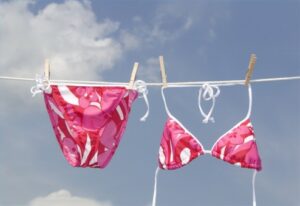How to Choose the Right Laundry Wash Cycle – Washing Machine Settings Guide
-
 By
Sophia Grant
By
Sophia Grant

Ever stared at your washing machine on laundry day, wondering what each of the cycles mean?
The dilemma is all too common: normal cycle or delicate cycle? Hot or cold water? And what on earth does ‘permanent press’ mean?
Understanding these wash cycle settings may feel like cracking an enigma code but don’t worry, we’ve got you covered!
In this post, we’ll be going over everything that you need to know about normal cycles, delicate cycles, and other cycles. Keep reading to learn more!
Table of Contents
ToggleUnderstanding Washer Cycles
The different wash cycles are crucial to getting your clothes clean. That is, they cater to a different group of everyday laundry items, from heavily soiled clothes needing a high agitation water washer cycle, to delicate fabrics requiring the gentlest cycle.
Generally speaking, the normal setting is the go-to for most loads. But when you need more cleaning power or want to speed things up, you may need to consider the other settings.
The Role of Water in Different Washer Cycles
Different washing machines use varying amounts of water during each cycle. For example, top load washers may fill completely for a heavy duty cycle with a high spin speed.
Washing Machine Cycles Explained
There are many different settings on your washing machine – from delicate wash cycle to speed wash. Here’s what you need to know about them.
The Most Common Wash Cycles

Different cycles use water differently for optimal cleaning results.
For example, the normal wash cycle, which is ideal for everyday items like cottons and linens, uses more water to ensure thorough cleaning.
The quick wash cycle, on the other hand, has a much faster spin speed than a normal wash cycle.
If anything, it’s perfect when you’re short on time but need that outfit ready.
There’s also a bulky wash cycle, which soaks large items longer with extra rinse cycles to make sure they come out fresh as possible. They can be a lengthy cycle, however.
Other notable settings include: ‘Permanent Press cycle’ for wrinkle-resistant fabrics (uses warm rinse instead of cold for wrinkle free clothing), ‘Delicate cycle’ (equivalent to a ‘hand wash cycle’ for lightly-soiled delicate fabrics) and finally the ‘Hand Wash cycle’ mode, which simulates gentle hand-washing.
Note: A permanent press cycle is a shortened wash cycle that generally lasts around 30 minutes.
How Water Temperatures Varies in Wash Cycles
There are a variety of options in your washing machine settings, from hot to cold water, and they all have specific uses that can affect your clothes’ cleanliness and longevity.
Hot Water Wash: Hot water is excellent for sanitizing heavily soiled items or cleaning durable fabrics like cotton. However, you want to be careful as it might cause shrinkage or color fading in some materials.
Warm Water Wash: The warm water setting offers a balance between removing dirt and preserving fabric integrity. It’s ideal for moderately dirty clothes made of synthetic fabrics.

Cool Water Wash: This is the gentlest cycle, which makes it great for washing delicate items, bright colors that are prone to bleeding, and lightly stained garments. It’s also the most energy-saving option as it doesn’t require electricity to heat up the water.
Keep in mind, however, that using cold wash exclusively may lead to detergent residue build-up in your washing machine tub over time. You can prevent this issue by alternating it with warm or hot water cycles.
Cotton Cycle: A setting that’s suitable for cotton clothes or garments that require high agitation (e.g. towels, bed sheets)
Picking the Right Temperature Setting
Selecting an appropriate water temperature isn’t just about following laundry symbols on clothing tags; it’s more about understanding how the water temperature interacts with different types of stains and fabrics.
For instance, protein-based stains (like sweat) respond better to colder temperatures while oil-based stains need warmer ones.
How to Choose the Right Washing Machine Cycle
The art of getting clothes clean isn’t just about throwing them into your washing machine. It’s a careful dance between choosing the right wash cycle, understanding fabric care needs, and recognizing how soiled items are.
Washing Your Laundry With the Right Settings
Certain types of clothing need more tender loving care than others. For instance, delicate items like silk blouses or lace undergarments should always be washed on the most gentle cleaning cycle available in your machine to prevent damage.
Step 1: Choose the Correct Load Size

Depending on how many items you’re washing, you’ll want to select a small, medium large, or super large load.
Step 2: Choose the Right Water Temperature

Selecting the right water temperature is crucial when it comes to preventing your clothes from stretching, shrinking, or fading.
For delicate fabrics and lightly-soiled clothes, we recommend using cold water. Hot water, on the other hand, is best for bed sheets, underwear, and socks.
Step 3: Choose the Right Wash Setting

We recommend using a gentle setting for delicates such as bras and lingerie. For other items, you can use a permanent press, normal, or heavy duty cycle, depending on the material.
Supply:
- Washing machine
- Sorted laundry
ACTIVE Washing Machine Cleaner
Cleaning your washing machine helps maintain performance during any wash cycle.

15% Off Your Order on Amazon
×Click below to reveal the 15% off coupon for your entire ACTIVE purchase on Amazon.com
Specialty Fabric Care
If you’ve got extremely soiled clothes such as muddy jeans or grease-stained work shirts, they’ll benefit from a higher spin speed during their normal cycle. But remember to check if these sturdy fabrics can handle it first.

Bulky items like sleeping bags or large comforters also require special washing cycles due to their load size. Fortunately, most modern washing machines offer dedicated settings for such large pieces.
Lightly soiled everyday items, on the other hand, generally do fine with normal cycles – saving energy and reducing wear-and-tear on both washer and clothes alike.
So next time before you load the washer, think carefully about which wash cycle will be most efficient.
Understanding Spin Speeds and Their Impact on Washing
Ever wondered about the spin cycle of your washing machine? As it turns out, it’s more than just a dizzying ride for your clothes – it plays a crucial role in how clean your laundry gets.
The higher the spin speed, the more water is removed from your clothes. This makes drying faster but can also be rough on delicate fabrics.
On the other hand, slower spins are gentler, leaving clothes slightly damp, which makes it ideal for items that need air-drying.
A high-speed spin cycle uses centrifugal force to extract water out of clothing fibers after they’re cleaned. These cycles often range between 1200-1800 RPM (rotations per minute), making them perfect for sturdy everyday items like jeans or towels.
Balancing Between High and Low Spin Cycles
Here are a few things to consider when it comes to spin speed:
- A quick wash cycle may sound efficient, but it might not suit all types of fabric
- Higher spin speeds are great when you want to reduce dryer time and save energy
- Consider using slower spins for delicate materials (e.g. silk) as they offer a gentle cycle while still getting rid of excess moisture effectively
Tips for Optimal Wash Cycle Selection
Choosing the right wash cycle is key to getting your clothes perfectly clean and extending their lifespan. Figuring out which washing cycle to use, however, can be a bit of a challenge with all the options on your washing machine’s dial.

Your owner’s manual should be your first stop when trying to understand which setting is best for different types of laundry – it will explain what each symbol means and offer suggestions based on fabric type or level of dirtiness.
Dirt Removal
For extremely soiled items, such as children’s clothing (e.g. cloth diapers) or work uniforms, you’ll want to use a high agitation wash cycle with hot water and an extra rinse if available. This provides the most rigorous cleaning action combined with liquid chlorine bleach, helping remove stubborn stains more effectively.
Saving Money by Choosing the Right Setting
If you’re looking to save money (and who isn’t?), selecting the correct wash time can make a difference in energy costs.
For lightly soiled everyday items like t-shirts or jeans or brightly colored garments, consider using a cold water wash on the normal setting – this uses less electricity than the warm or cold water cycles but still rinses clothes efficiently.
Other Things to Consider
We often forget about the little details when it comes to washing our clothes. One such detail is the water level in your washing machine tub.
Choosing a higher water level can help wash heavily soiled items better. But remember, more isn’t always merrier. Too much water may not give you clean clothes as there’s less friction between them.
Hand Wash Delicate Items
Ideally, you want to hand wash your delicate items (e.g. undergarments, baby clothes). Throwing them in the washing machine along with your other laundry can cause them to wear out faster than you’d like, even if you put them in a mesh laundry bag.
For example, it can cause the fabric to pill, or worse, break down.
Different Washing Machine Cycles – FAQs
What are the 3 most common wash cycles?
The three most common washing machine cycles include Normal for everyday laundry (e.g. lightly soiled clothes), Delicate or Gentle (equivalent to a ‘hand wash cycle’) for fragile items, and Heavy-Duty for extremely soiled clothes.
What is the difference between the various washing machine cycles?
Different washer cycles cater to varying fabric types and dirt levels. More specifically, they have different water temperatures, agitation speeds, rinse cycle lengths, and spin speed settings.
What does each washer cycle do?
Each washer cycle provides specific care based on clothing type. For example, Delicate uses low or no spin for gentle cleaning while Heavy-Duty employs robust action for stain removal. The permanent press setting, on the other hand, uses warm water during the wash and cold water during the rinse stage.
Which wash cycle should I use?
Your wash cycle depends on the item that you’re washing. Generally speaking, you want to use the normal setting for regular clothes and switch to delicate, permanent press, or heavy-duty accordingly.
SAVE
15% off
Your Next ACTIVE
Purchase on Amazon
15% Off Your Order on Amazon
×Click below to reveal the 15% off coupon for your entire ACTIVE purchase on Amazon.com
Limited Time Offer




